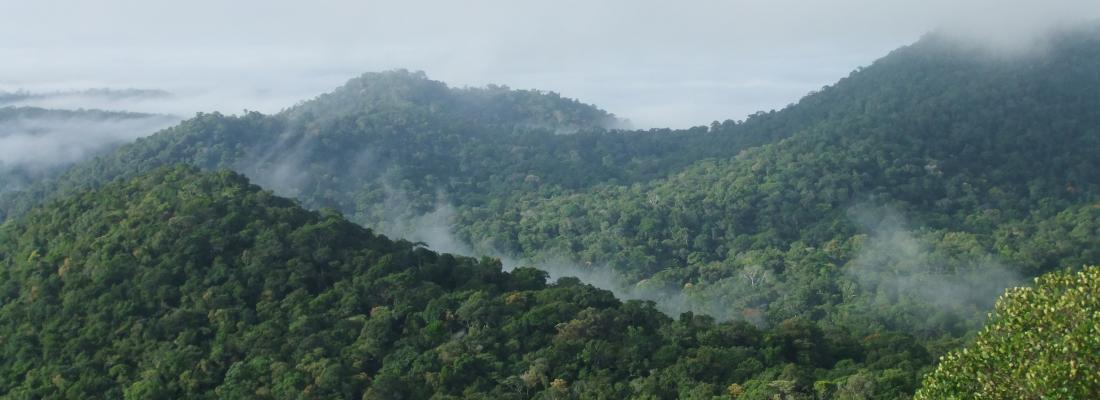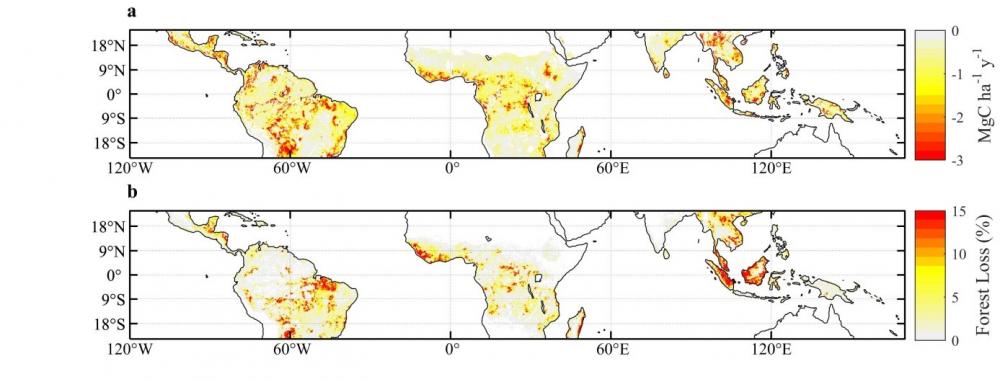Climate change and risks Reading time 3 min
Aboveground vegetation biomass in the tropics no longer has a positive impact on carbon stocks
Published on 29 July 2019

How do the carbon stocks of aboveground vegetation biomass change globally ? How can we explain these changes ? These are central questions in climate science and for the international agreement on climate change. In 2018, scientists from INRA, CEA, CNRS, CNES, and several international universities (Nanjing, Copenhagen) published a new method of mapping annual changes in the aboveground vegetation biomass at continental scales. The method was applied only over Sub-Saharan Africa**.
The results published in the current study go further and analyze the changes in the aboveground vegetation carbon (AGC) stocks over the whole tropics. The study highlights the strong correlation between the changes in the tropical biomass carbon stocks and changes in the CO2 atmospheric concentration, confirming the pivotal role of tropical aboveground biomass in the global carbon cycle.
For the first time, in the published study, direct and quantitative space-borne observations of stocks of above ground biomass over the whole tropics revealed the quasi-neutrality of tropical vegetation when computing the carbon budget in the tropics, taking into account deforestation.
The carbon budget in AGC was estimated to be equal to +0.11 Gt (billion tons) of carbon each year over 2010-2017, thus compensating for only ~ 1% of the yearly anthropic emissions of carbon. Note however that the method is not able to estimate changes in carbon stocks in soil or in the vegetation roots, and thus represents only a partial carbon budget.
To date, the only results on this key question were obtained from simulations of land surface models or from the inversion of atmospheric models.
The results can be explained as follows: the positive impact of vegetation in the tropics which limits the increase of carbon in the atmosphere, through carbon storage in aboveground biomass is becoming neutral. Gains obtained in regions where the vegetation is a carbon sink (estimated at +2.97 Gt C / year), for instance in pristine forests in the center of the Amazon and Congo basins, are now almost compensated for by carbon losses (estimated at -2, 86 Gt C/ an), in relation with deforestation and diebacks due to the impact of climate (in particular the consequences of the El Niño events; the El Niño event in 2015-2016 in particular was extremely warm and dry).
Each year, deforestation continues (or accelerates), limiting the sequestration capacity of carbon in tropical regions. So, the results of this study suggest that we are in a transition period, during which tropical regions have shifted from a role of carbon sink to a quasi-neutral role that may prefigure a future phase during which tropical regions would become a carbon source for the atmosphere, thereby accelerating global warming.

|
| Losses of carbon and deforestation in the tropics (2010-2017) : maps (a) of gross losses of above-ground biomass carbon estimated with the SMOS L-VOD index (Mg C ha-1 an-1) and (b) and forest surface losses due to deforestation (%) as estimated by Hansen et al. (Science, 2013). Areas in red correspond to the largest losses in vegetation biomass and to the most intense deforestation activities. In particular, we note (Fig. b), the arc of deforestation in Amazonia and an intense deforestation activity in Indonesia and in central and western Equatorial regions of Africa which are well correlated (Fig. a) to large losses in vegetation biomass as revealed by the space-borne SMOS observations. The study estimated the losses in biomass due to deforestation in the tropics to 780 million tons of carbon each year. |
*Laboratoire des Sciences du Climat et de l'Environnement (LSCE, UVSQ/CNRS/CEA), Laboratoire Evolution et Diversité Biologique (EDB, ENSFEA/CNRS/Université Toulouse III - Paul Sabatier), Unité Interaction Sol Plante Atmosphère (INRA, Bordeaux Sciences Agro), Centre d'Etudes Spatiales de la BIOsphère (Université de Toulouse, CNES/CNRS/IRD/UPS).
**Brandt et al, Satellite passive microwaves reveal recent climate-induced carbon losses in African drylands, Nature Ecology & Evolution, Apr 9, 2018 doi: 10.1038/s41559-018-0530-6
See the INRA/CEA/CNRS/Cnes press release of 9 April 2018: A new tool to monitor the carbon budget of vegetation: first application to the African continent: https://www.inrae.fr/presse
| 'Satellite-observed pantropical carbon dynamics'. Lei Fan, Jean-Pierre Wigneron, Philippe Ciais, Jérôme Chave, Martin Brandt, Rasmus Fensholt, Sassan S. Saatchi, Ana Bastos, Amen Al-Yaari, Koen Hufkens, Yuanwei Qin, Xiangming Xiao, Chi Chen, Ranga B. Myneni, Roberto Fernandez-Moran, Arnaud Mialon, N. J. Rodriguez-Fernandez, Yann Kerr, Feng Tian, Josep Peñuelas. Nature Plants. 29 July 2019. DOI: 10.1038/s41477-019-0478-9 |
